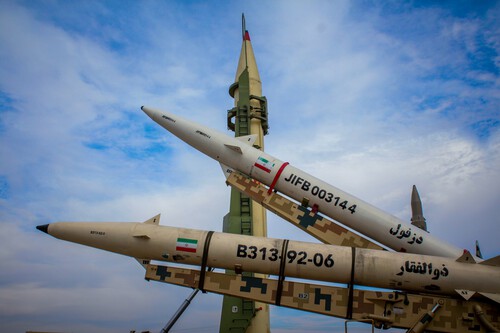It could be the stuff of an apocalyptic science fiction movie. A missile with anti-ballistic, hypersonic and exoatmospheric capabilities is launched in pursuit of its target—a Mach 5 ballistic missile whose technology surpasses the Kármán line, 930 miles away. These two sophisticated systems meet in the exosphere to determine a winner. This scene is unfolding at this very moment, completely changing our understanding of armed conflict.
The invisible theater. The war between Israel and Iran is an unprecedented turning point in the history of armed conflict because of its political implications and the radical nature of its means and dimensions.
What began as a predictable escalation backed by decades of latent tensions has turned into a confrontation without borders, land fronts and armies facing each other—an enhanced version of what we had already seen in Ukraine.
Since their capitals are more than 930 miles apart, with no shared borders or direct involvement from neighboring countries, both states are attacking each other by flying over and crossing each other’s airspace. Israel is deploying its air power over Iran with a fleet of long-range F-35, F-15, and F-16 aircraft that are refueled in flight and operate with total impunity in foreign airspace. This operational freedom is only possible because, after years of sanctions, Iran lacks the air power to offer resistance. Any moving object in Iranian skies must be considered an enemy.
An asymmetrical air war. While Israel uses fighter jets and guided bombs—including U.S.-made bunker-busting bombs—to carry out precision strikes, Iran responds with a more economical but no less ambitious strategy: long-range ballistic missiles, as Columbia historian and professor Adam Tooze said.
It’s an asymmetrical war. Israel flies hundreds of miles to drop bombs. Iran launches missiles that travel the same distance through the air.
Each of these projectiles can cost millions of dollars. Yet, together, they represent only a fraction of the value of Israeli aircraft. Extraordinarily, these missiles reach targets more than 620 miles away and cross the Kármán line, the boundary of outer space. They reach altitudes of up to 250 miles before plunging toward their targets. These exoatmospheric trajectories are unprecedented in real conflicts. They’re a direct evolution of the technical legacy of Nazi Germany’s V-2 rockets, which were adopted by the Soviet and Iranian programs.
The “stellar” shield. Here, we see an element that seems straight out of science fiction. Israel’s response to these cosmic attacks is equally futuristic. Thanks to decades of collaboration with the United States, Israel has deployed the Arrow 3 system, an interceptor capable of neutralizing ballistic missiles in space.
Developed by IAI, Boeing, Elta, and Elbit Systems, the system is derived from Ronald Reagan’s Strategic Defense Initiative program. It’s based on the premise of “hitting a bullet with another bullet,” albeit with one drawback: a cost of $2 million per unit. These interceptors reach Iranian missiles at their highest point before they even enter Israeli airspace. The first successful interception in combat occurred Nov. 9, 2023, marking a milestone as the first time a missile was destroyed in space during a war.
The dome and the price to pay. According to Tooze’s anecdote, these stellar defenses were used for a specific purpose. During the massive attack in April 2024, more than 550 projectiles—including ballistic and cruise missiles—were launched against Israel. The air defense system responded successfully, averting a cataclysmic event. Tooze said the tangible result of that night was that the population returned to work as usual.
However, that level of protection comes at an exorbitant price: up to $285 million per night for defensive operations, according to The Washington Post. Additionally, the production of interceptor missiles is limited. Israeli and U.S. factories can’t manufacture enough Arrow 3s to sustain that long-term pace. The big strategic question in the current conflict is which side will exhaust its arsenal first: Iran with its missiles or Israel with its interceptors.
Europe is in the background. While the U.S. and its allies closely watched Reagan pursue this kind of real-life “Star Wars,” Europe seemed determined to act.
Under the German-led Sky Shield project, billions of euros’ worth of Arrow 3 batteries has been ordered for the much-touted rearmament the U.S. and its allies desperately want. While Israeli experience doesn’t automatically translate to defending the U.S. mainland against ICBMs, it does translate to protecting the European continent. Europe sees this shield as a response to future threats.
A new paradigm of warfare. In the background is something that has been sensed since the drone war unleashed after the Russian invasion of Ukraine—a feeling reinforced by this missile confrontation between Israel and Iran: the dawn of a new military era. Conventional wars, where fronts were measured in land miles, are a thing of the past.
Today, war is no longer confined to a single geographical location. Attack trajectories cross continents and atmospheres, and battles are fought everywhere—from the exosphere to the basements of nuclear facilities buried in mountains. What once seemed like science fiction—intercepting rockets in space, living under invisible defensive domes and coordinating surgical strikes 930 miles away—is now part of the world’s most militarized states’ routine arsenal.
It’s an unprecedented experiment. First, it was Ukraine. Now, the war between Israel and Iran has confirmed a radical break in geostrategic terms. This isn’t only due to its scope or its protagonists but also to the types of technologies employed, the scenarios in which the war is being fought and the fundamentally technical, automated, and remote nature of its operations.
This is no longer just a regional confrontation. It signals the dawn of an orbital era of remote warfare where supremacy is defined by satellite intelligence, space-based ballistic defense and sustained industrial capabilities. This conflict signals a transformation that will influence how wars are planned, fought, and remembered.
Image | Moslem Danesh (Unsplash)
Related | Israel’s Other War Against Iran: It Just Stole $90 Million in Cryptocurrency




View 0 comments